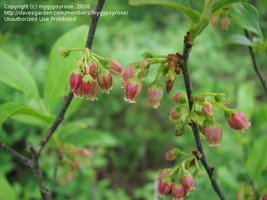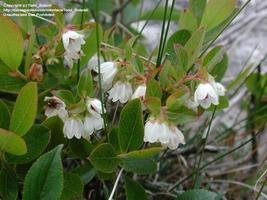





Every summer during my childhood, my family and I picked what I always believed were huckleberries. They were the main ingredient in many tasty dumplings, cobblers, pies, pancakes, and jellies. I have since learned, however, that what we thought were huckleberries were actually blueberries. We were not the only ones confused about their identity.
In many parts of the United States, blueberries are mistakenly called huckleberries. Some people believe that blueberries are always blue while huckleberries are black or very dark purple. This is erroneous thinking, however, for some blueberries are very dark colored, and some huckleberries are very blue. One sure way to tell is to examine the seeds. Blueberries have many small, tiny, soft seeds, while huckleberries have ten large, crunchy seeds.
Both huckleberries (Gaylussacia) and blueberries (Vaccinium) belong to the heath family (Ericaceae). About 50 species have been identified. The majority of them are native to South America, while seven or eight species are native to the eastern United States. While many of the western states claim to have huckleberries, what they really have are members of the closely related Vaccinium genus.
Generally speaking, leaves of the Gaylussacia species are alternate, and the undersides have yellow resin dots that can be seen with a hand lens. This resin causes the leaves to be somewhat sticky. Some species are evergreen while others are deciduous.
Flowers are white to pink and urn or bell-shaped, and appear in spring in small axillary clusters. Fruits are small, round, shiny berrylike drupes that ripen in late summer. Shrubs are multi-stemmed, slender, and arise from underground rhizomes.
Kinds of Huckleberry
Some confusion surrounds the identity of the North American native species. Germplasm Resources Information Network (GRIN) recognizes only seven native species, while eight are listed on the USDA Plants Database. One listed on the GRIN site is native to South America (Gaylussacia buxifolia). Gaylussacia tomentosa is listed by USDA, but not by GRIN. Also, USDA recognizes G. nana (Confederate huckleberry), while GRIN lists it as a variety of G. frondosa.
 Black huckleberry (Gaylussacia baccata) seems to be the species that is most widely distributed in North America. Its range covers the eastern half of the United States and Canada. Flowers of this deciduous species are dark pink to red. Individual plants grow from 1 to 3 feet tall, but it forms colonies so that one plant is hard to distinguish from another. It thrives in dry woods and forests in rocky, sandy soil.
Black huckleberry (Gaylussacia baccata) seems to be the species that is most widely distributed in North America. Its range covers the eastern half of the United States and Canada. Flowers of this deciduous species are dark pink to red. Individual plants grow from 1 to 3 feet tall, but it forms colonies so that one plant is hard to distinguish from another. It thrives in dry woods and forests in rocky, sandy soil.
Box huckleberry (Gaylussacia brachycera) has a much smaller range. It is found on hills and mountains from Pennsylvania to Virginia, Kentucky, and Tennessee. This dwarf, evergreen shrub forms large colonies. It is reported that one colony in Perry County, Pennsylvania, is about a mile long and is over 12,000 years old. Unfortunately, the species is at moderate risk of extinction due to overtopping by fast-growing invasive species, erosion following logging operations, natural plant succession resulting in a loss of habitat, and irresponsible development as humans encroach on its range.
The dwarf huckleberry (G. dumosa) is a wetland species that is threatened in parts of its range. It can be distinguished from other huckleberries because fruits are foliaceous (interspersed with small leaves), and each full-sized leaf has a tiny pointed tip. Dwarf huckleberry grows from 8 to 24 inches tall and is found in most of the states near the eastern seaboard.
A few of the species are restricted to the southern United States. Wooly huckleberry (G. mosieri), Confederate huckleberry (G. nana), hairytwig huckleberry (G. tomentosa), and bear huckleberry (G. ursina) are denizens of the Deep South. Bear huckleberry, for instance, is a deciduous, colony-forming shrub found only in Tennessee, North and South Carolina, and Georgia. Wooly huckleberry is a bit more widespread and can be found in acid bogs, pitcher plant communities, and streamside baygall communities in Florida, Louisiana, Alabama, Georgia, and South Carolina. Confederate huckleberry, found only in Florida, Alabama, and Georgia, has the narrowest range of all.
Importance to Wildlife
Huckleberries can be found growing wild in most of the eastern United States. While they are not as popular as the true blueberries (Vaccinium spp.) for human consumption, they are important to wildlife. Many songbirds as well as ruffed grouse, bobwhite quail, and turkey consume the fruits. Small mammals also eat the fruit, and deer browse the twigs and foliage. Some butterflies seek them out as larval host plants, and several types of bees gather nectar and serve as pollinating agents. In addition, they are wonderful native plants that add to the diversity of our woods and landscapes.
Thanks to Todd Boland and mygypsyrose for images of Gaylussacia dumosa and G. baccata.
Copyright © www.100flowers.win Botanic Garden All Rights Reserved